Czech Easter time is associated with many delicious events in the kitchen. All kinds of goodies are made, among which the Easter lamb cake stands out. This easy, detailed recipe shows you how to bake lamb cake so that you succeed on your first try!
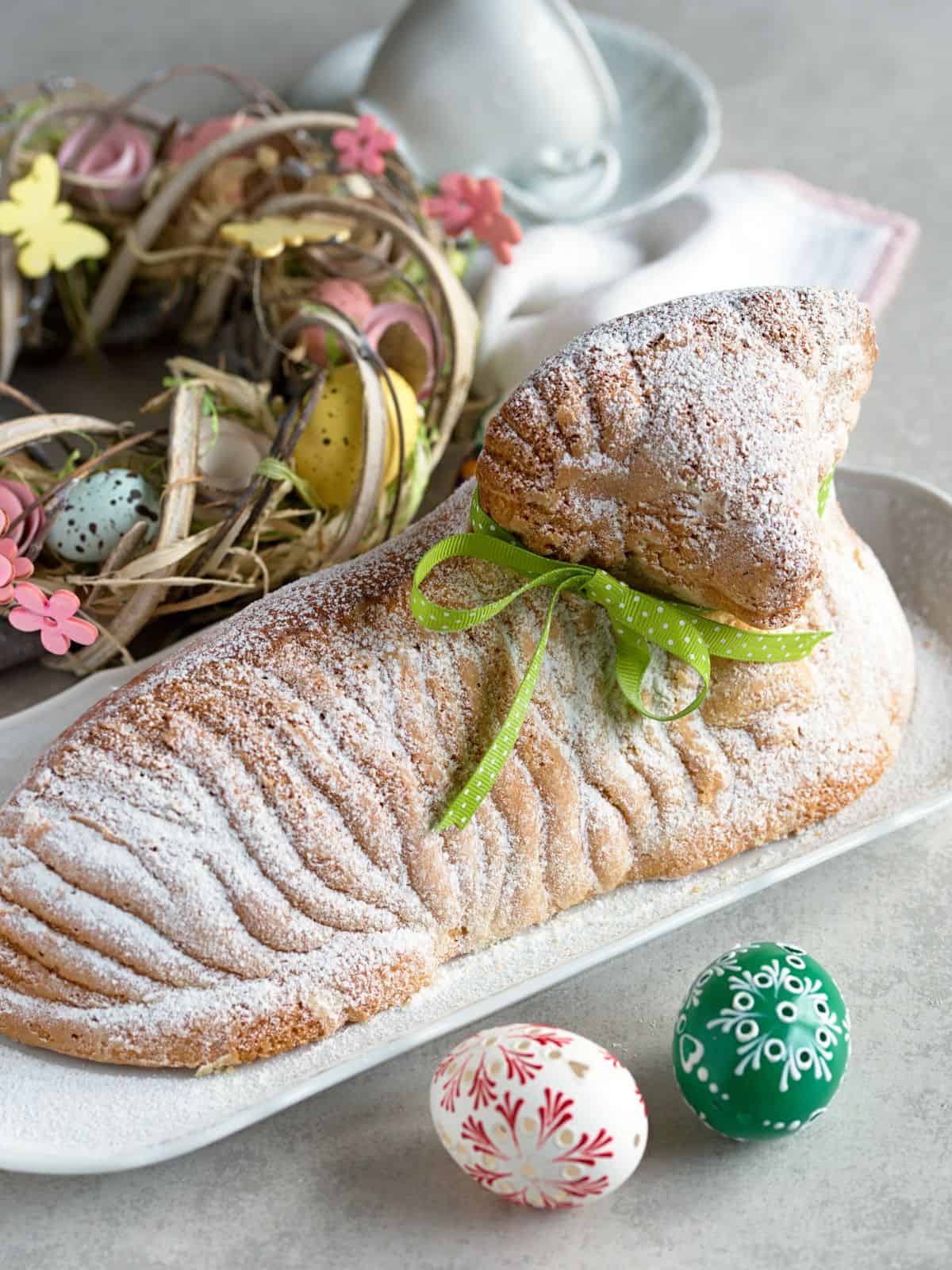
Lamb cake is traditionally baked on Holy Saturday (known as Bílá sobota, or White Saturday in Czech). Historically, people would bring the cake to church on Easter Sunday for a priest to bless.
Similarly, the priest blessed other Czech ritual dishes, such as Mazanec bread.
➜ What is Czech Easter lamb cake?
The Czech Easter lamb cake is a sweet sponge cake made in a mold shaped like a lamb.
After baking, let the cake cool, then grab a sieve and powdered sugar. The Czech way of cake decorating is straightforward; Czechs rarely glaze sweets baked in pans with melted chocolate or use buttery frosting.
Simply dust the surface with powdered sugar and let its beautiful shape shine through.
For a nice presentation, tie a bow around the lamb's neck in the colors of spring—green, red, or yellow. If you want perfection on the lamb's face, put two raisins in place of its eyes. Transfer the cake to a platter and arrange it on the Easter table.
NICE TO KNOW: For Czechs, baking a lamb cake is a popular Easter tradition; they call it "Velikonoční beránek." Here is the Czech pronunciation:
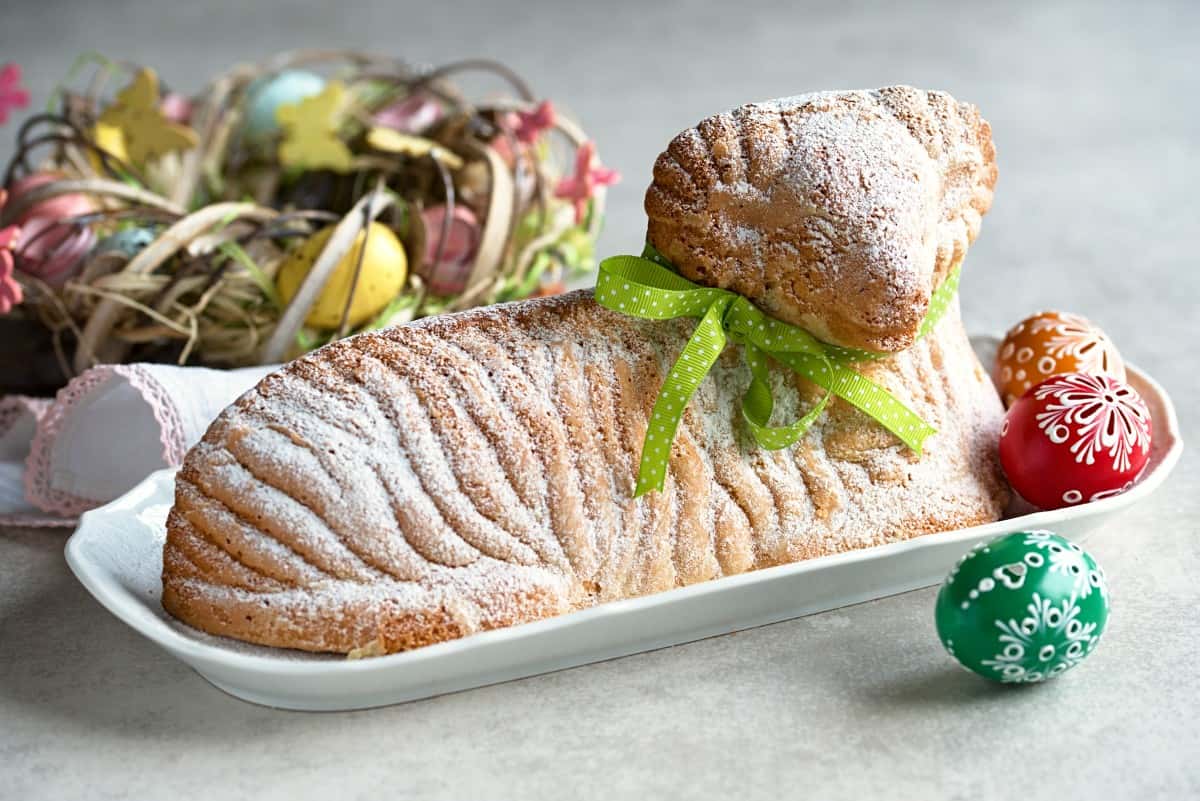
➜ Why is lamb cake baked at Easter?
For Christians who commemorate Easter as the time of Jesus Christ's crucifixion, a lamb symbolizes purity and innocence. During the Middle Ages, a living lamb used to be sacrificed and eaten as a ritual meal in the Czech Republic.
However, most Czech people were poor, especially in the countryside, and therefore a sacrificial lamb turned into the sweet cake we know and love today.
Beautiful vintage lamb molds made of cast iron or stoneware, inherited from parents, can still be found in many Czech households!
Here you can read more about Czech Easter traditions
➜ Ingredients
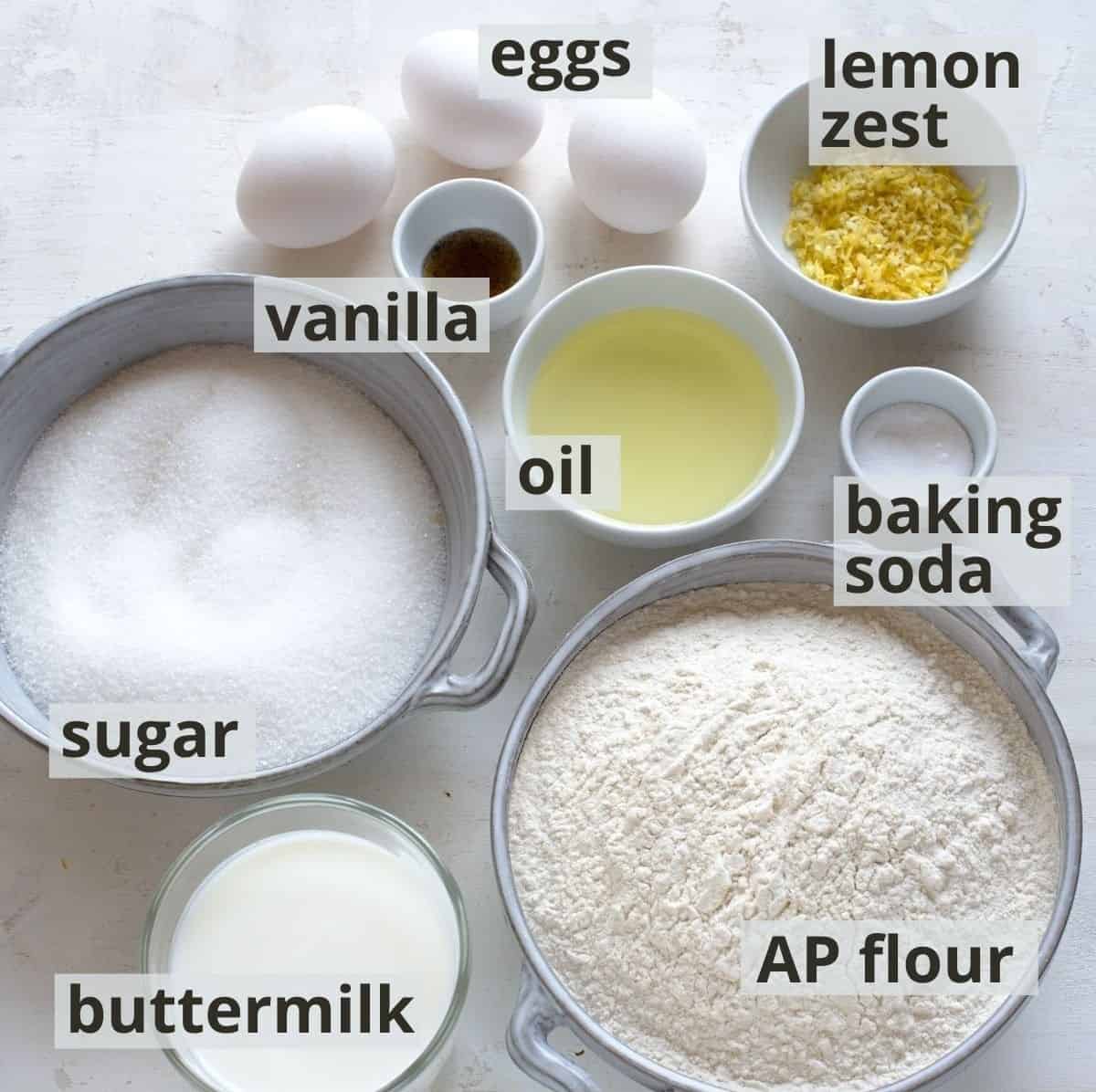
Easter lamb cake is one of the vintage recipes that counts as a holiday meal. To make it, you need the following:
- Whole eggs; at room temperature (not egg yolks and whites separated)
- Sugar; granulated
- Buttermilk; the sour milk product gives the lamb the necessary smoothness. Take the buttermilk out of the fridge about an hour in advance and let it come to room temperature.
- All-purpose flour
- Lemon zest; freshly grated from a thoroughly washed lemon. Ideally, use organic lemon.
- Vanilla paste; or vanilla essence
- Baking oil; such as sunflower or Canola. Do not use olive oil, it is too aromatic for this delicate pastry.
- Baking soda; not baking powder
You’ll also need a bit of butter and sifted plain breadcrumbs to grease and dust the lamb cake pan.
✅ You’ll find the exact amount of ingredients below in the recipe card, which you can also print out.
➜ Instructions with Photos
STEP 1: Take the eggs out of the fridge at least an hour in advance. Crack them into a large bowl and use an electric mixer to beat them with granulated sugar. Start at a lower speed, gradually add the sugar (not all at once), and increase the speed. Be patient; it takes at least 5 minutes to whip enough, more like longer. The result should be a light, airy foam.
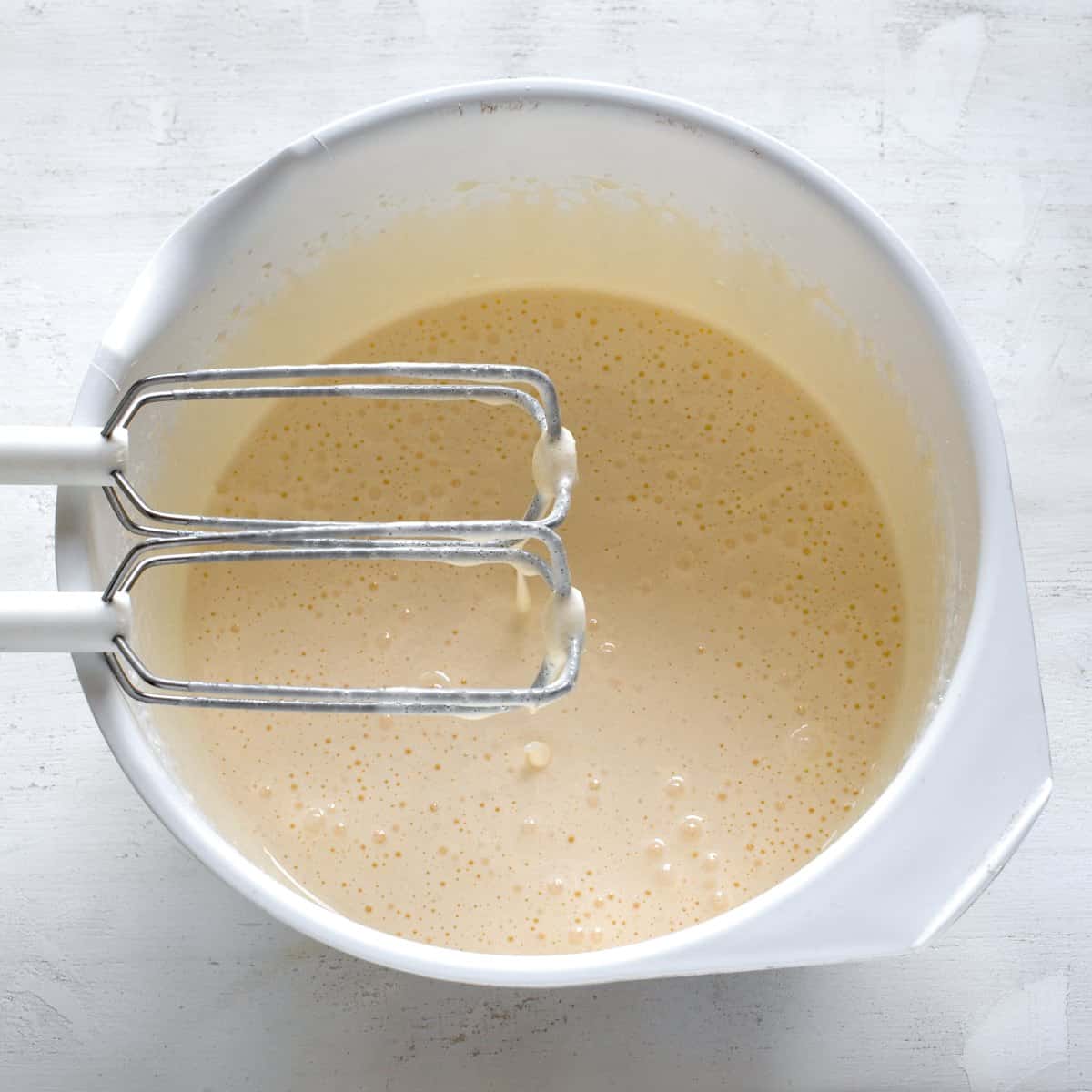
STEP 2: Reduce the speed to a minimum, and add the vanilla and lemon zest. Gradually whisk in the buttermilk and oil.
STEP 3: Combine the flour and baking soda. Add the mixture gradually to the batter, slowly whisking it in.
STEP 4: Grease the lamb mold thoroughly with oil and dust with flour. Butter can be used instead of oil to help the flour adhere well to the mold's inner surface. Consider that buttering the mold will take a little more effort.
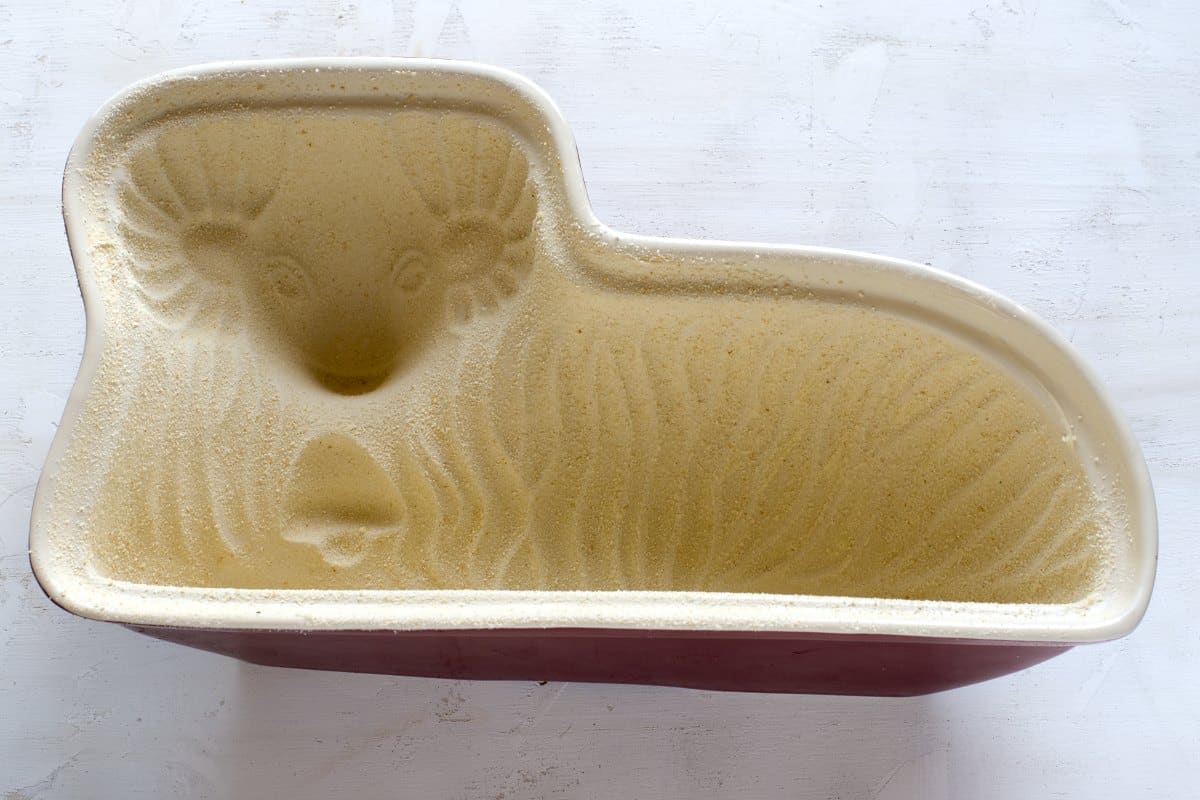
⇢ Learn how to grease and flour a pan for cakes
STEP 5: Pour the batter into the prepared pan; it should reach about 1¼ inches (3 cm) below the pan edge as it will puff up during baking.
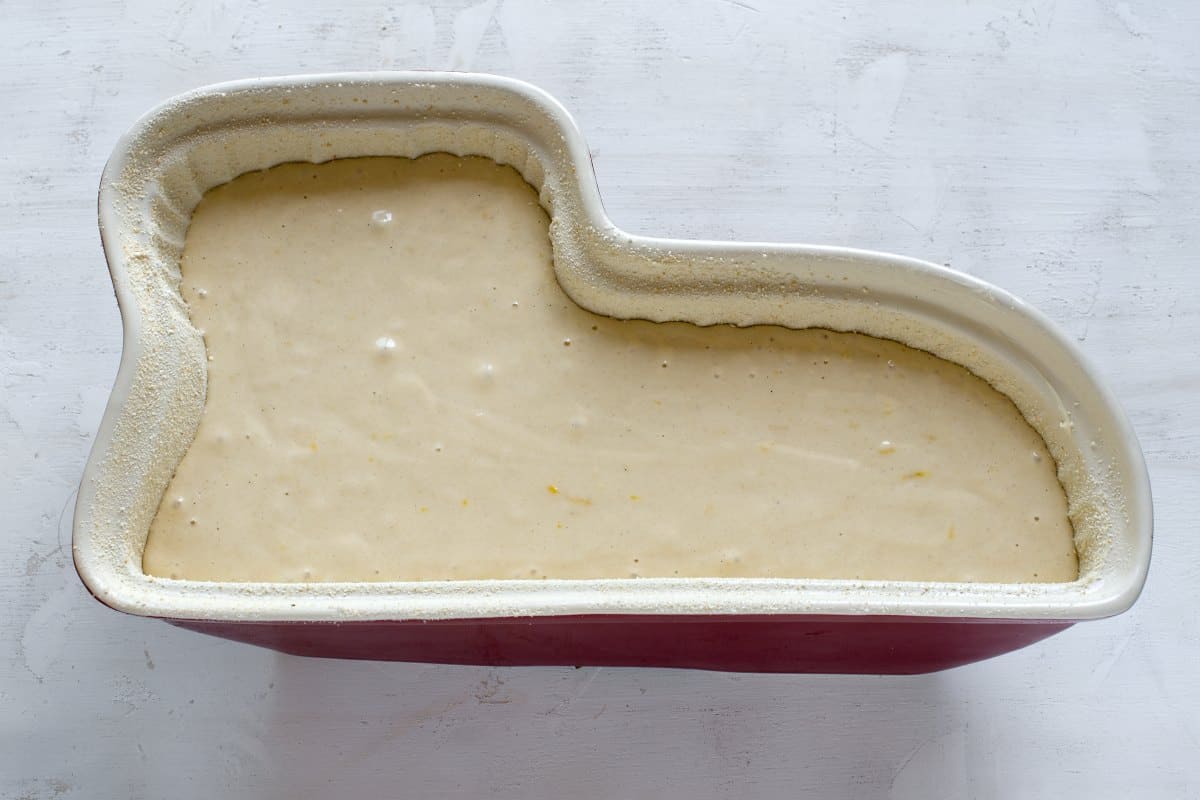
STEP 6: Place in an oven preheated to 350°F / 177°C (upper and lower heating) for 1-1¼ hours.
At the end of baking, do a test for doneness. Stick a wooden skewer into the lamb. If it comes out dry, the lamb is baked. If there is any residue of raw dough on the skewer, leave the lamb to bake for a further five minutes and then repeat the test again.
⇢ More about that: How to tell when my cake is done
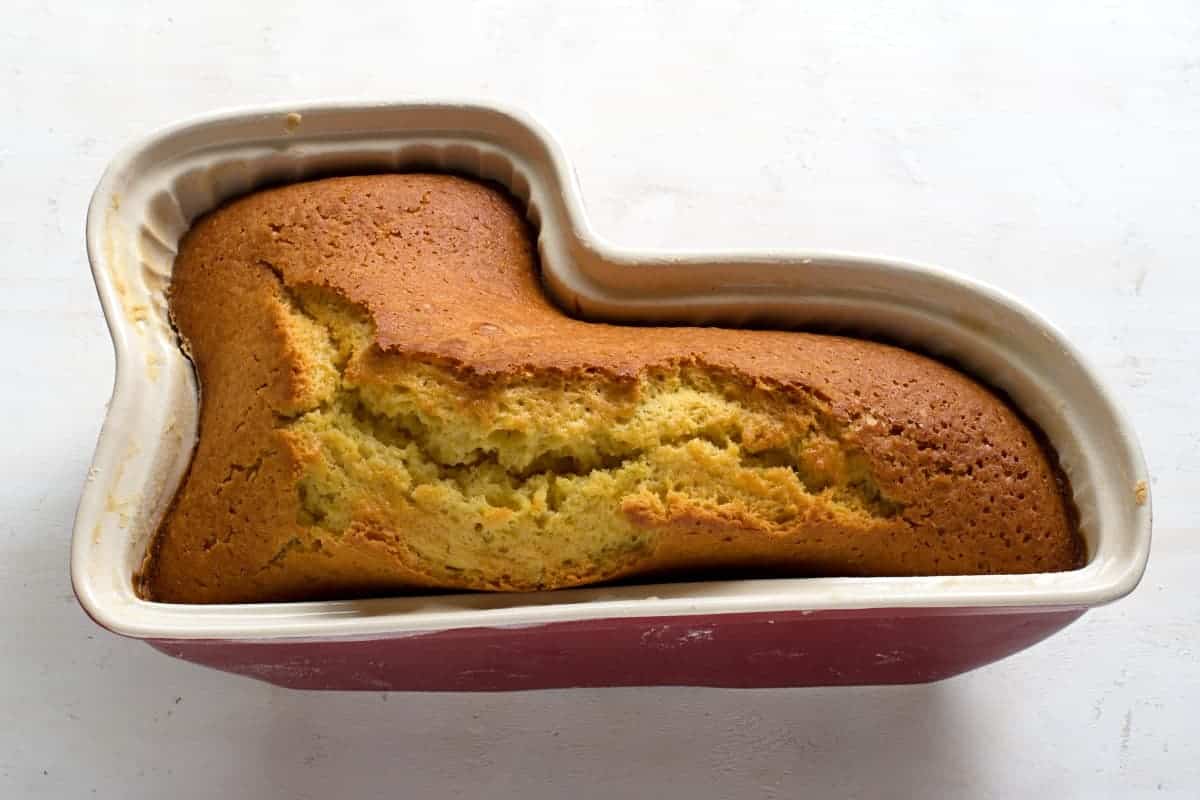
➜ How to safely unmold the cake
Let the baked lamb stand for about 10 minutes. Then carefully flip it over and test whether the lamb has separated from the mold.
If it sticks, place a tea towel, soaked and wrung out in cold water, over the mold. Leave it to sit for a while; then you should be able to get the lamb out of the mold without any further problems.

TIP: The key to smoothly removing the lamb is proper preparation of the mold before baking
➜ Lamb cake mold size
I bake the lamb cake in a one-piece ceramic mold from the Czech company Tescoma. The mold should be available worldwide on Amazon if you would like to get one.
I have measured the mold's dimensions for you to give you an idea of what size it is. This is important when estimating the amount of batter—so that it is not too little and, on the flip side, so that it doesn't spill out of the mold when baking.
Size of the lamb cake pan:
- Volume: 8 cups / 1.9 L
- Length: 12" / 30 cm
- Height at head: 7" / 17.5 cm
- Height at the bottom: 5" / 12.5 cm
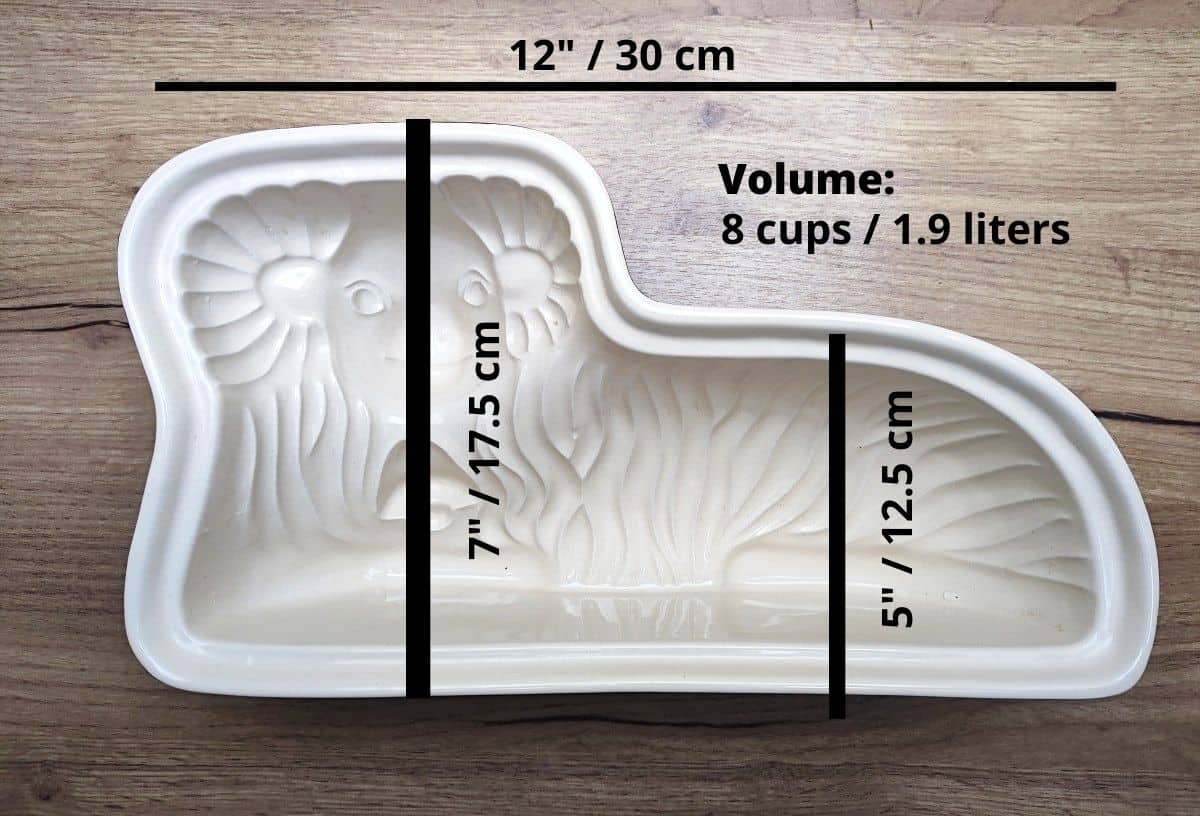
➜ Preparing the lamb mold
Grease the mold thoroughly, including every little wrinkle. Use a little melted butter and a pastry brush to simplify the work. After that, dust the mold with sieved breadcrumbs.
This way, the cake will not stick to the pan sides, and it will be easy to take the lamb out after it’s baked. The shape of a lamb, especially the head of the cake, will be regular, with all details visible.
Here you’ll find more Czech Easter recipes
➜ Serving
Let the lamb cool, then dust it with icing sugar. Tie a bow around the neck in cheerful spring colors (green, yellow or red) and arrange it on a platter.
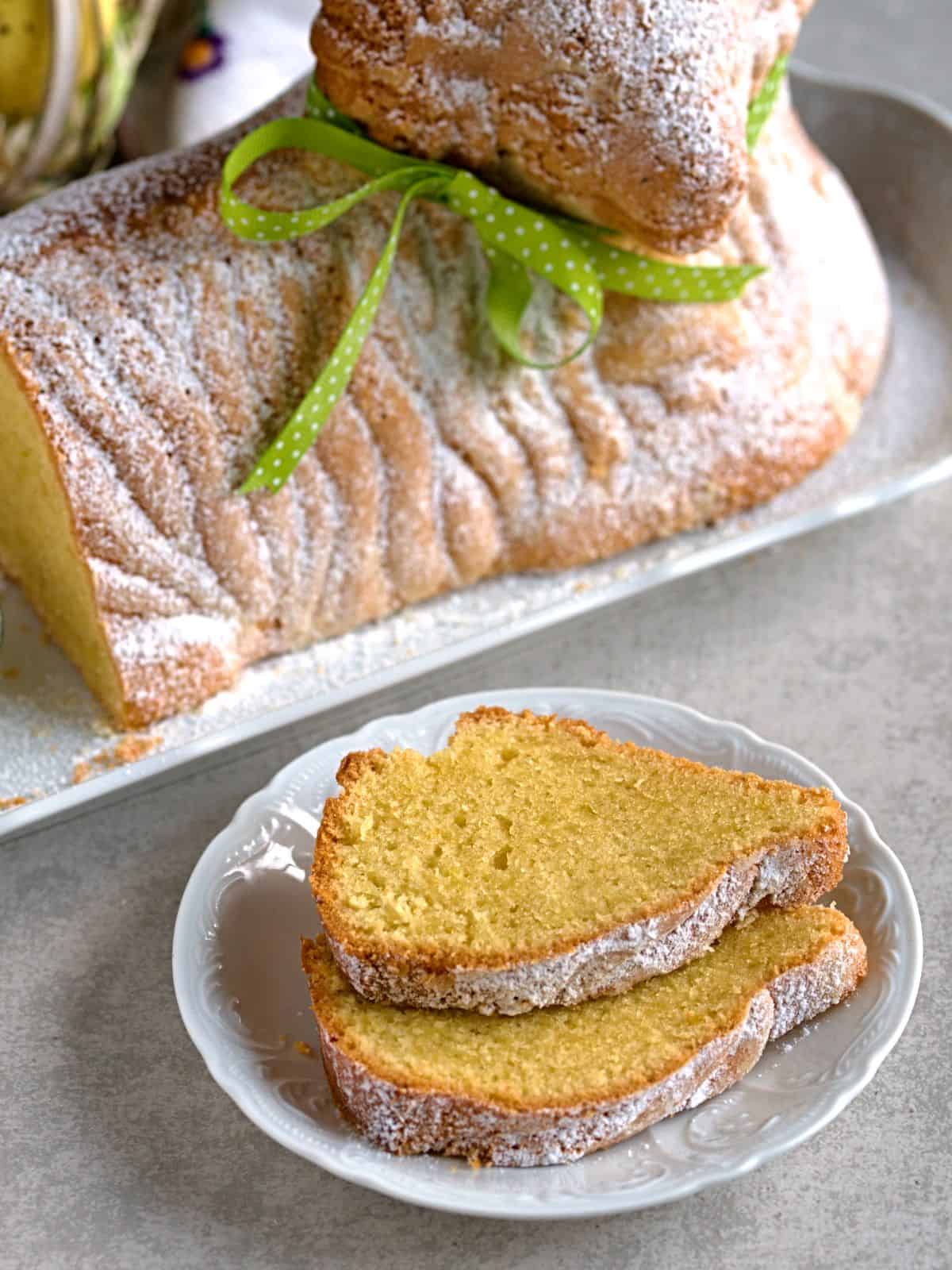
Still craving something delicious and sweet? Try Medovník, a famous Czech honey cake!
➜ Tips for success
- If necessary, cut the bottom of the baked cake with a sharp knife so that the lamb stands upright.
- If your lamb mold is made of ceramic, take the lamb out of the oven in time. Otherwise, its edges could be overcooked. Ceramic and cast-iron molds take longer to heat up but still glow when they come out of the oven.
- Choose a lamb cake pan that has a wider neck. Molds with narrower necks risk breaking the head off - either when removing the lamb from the mold or when handling the cake after baking.
More Czech Easter recipes:
- Jidáše – Czech Easter sweet yeasted pastry
- Easter stuffing – Czech "hlavička" stuffing loaded with herbs and smoked meat
- Boží milosti – a sweet treat made with white wine
- Easter biscuits – jam-filled
- Easter birds – made with sweet yeast dough
- Sweet braided Easter bread
Tried this recipe?
Leave a review down in the comments! ⭐⭐⭐⭐⭐
Follow me on Facebook and Pinterest. Subscribe to my newsletter. Send me any question about Czech cuisine to my e-mail. I love hearing your feedback!
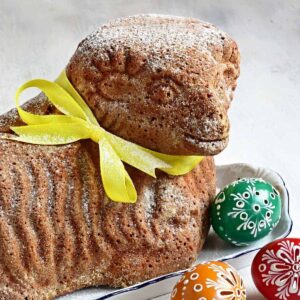
Czech Easter Lamb Cake
Ingredients
- 3 eggs at room temperatur
- 1 and ¼ cups granulated sugar
- 1 and ¼ cups buttermilch at room temperature
- 2 and ½ cups all-purpose flour
- 2 Tablespoons lemon zest freshly grated from about 1 smaller lemon
- 1 teaspoon vanilla paste or vanilla essence
- 2 teaspoons baking soda not baking powder
- ¼ cup sunflower oil or Canola
Misc.
- 1 Tablespoon solid fat for greasing the mold
- 1 Tablespoon sifted breadcrumbs for flouring the mold
- 2 Tablespoons powdered sugar to dut the lamb cake
Instructions
- Take the eggs out of the fridge at least an hour in advance. Crack them into a large bowl and use an electric mixer to beat them with granulated sugar. Start at a lower speed, gradually add the sugar (not all at once), and increase the speed. Be patient; it takes at least 5 minutes to whip enough, more like longer. The result should be a light whipped foam.
- Reduce the speed to a minimum, and add the vanilla and lemon zest. Gradually whisk in the buttermilk and oil.
- Combine the flour and baking soda. Add the mixture gradually to the batter, slowly whisking it in.
- Grease the lamb mold thoroughly with oil and dust with flour. Butter can be used instead of oil to help the flour adhere well to the mold's inner surface. Consider that buttering the mold will take a little more effort.
- Pour the batter into the prepared pan, it should reach about 1¼ inches (3 cm) below the edge of the pan as it will puff up during baking.
- Place in an oven preheated to 350°F / 177°C (upper and lower heating) for 1-1¼ hours.
- At the end of baking, do a test for doneness. Stick a wooden skewer into the lamb. If it comes out dry, the lamb is baked. If there is any residue of raw dough on the skewer, leave the lamb to bake for a further five minutes and then repeat the test again.
Notes
- The ingredients are meant for a lamb mold about 13 inches (33 cm) in size.
- Greasing the mold: Grease the entire mold really thoroughly, including every little wrinkle. Use oil or butter for greasing. After that, dust the mold with sieved breadcrumbs.
- How to unmold the lamb cake: Let the baked lamb stand for about 10 minutes. Then carefully flip it over and test whether the lamb has separated from the mold. If it sticks, place a tea towel, soaked and wrung out in cold water, over the mold. Leave it to sit for a while, then you should be able to get the lamb out of the mold without any further problems.
- Decorating: Let the lamb cool, then dust it with icing sugar. Tie a bow around the neck in cheerful spring colors (green, yellow, red) and arrange it on a platter.
- If necessary, cut the bottom of the baked cake with a sharp knife so that the lamb stands upright.
DISCLAIMER: Because I come from Central Europe, my recipes are based on metric units such as grams or milliliters. Check out how I convert metric units to the U.S. system:
Conversion chart

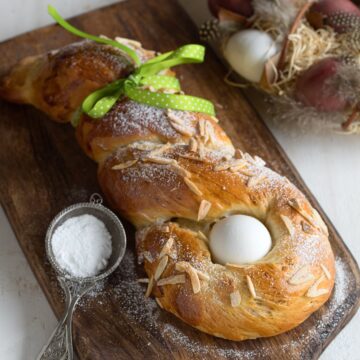
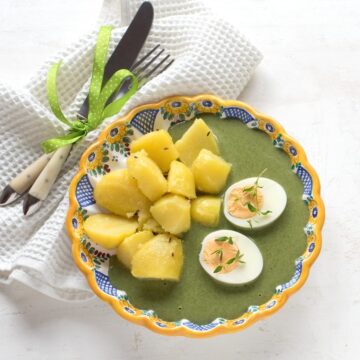

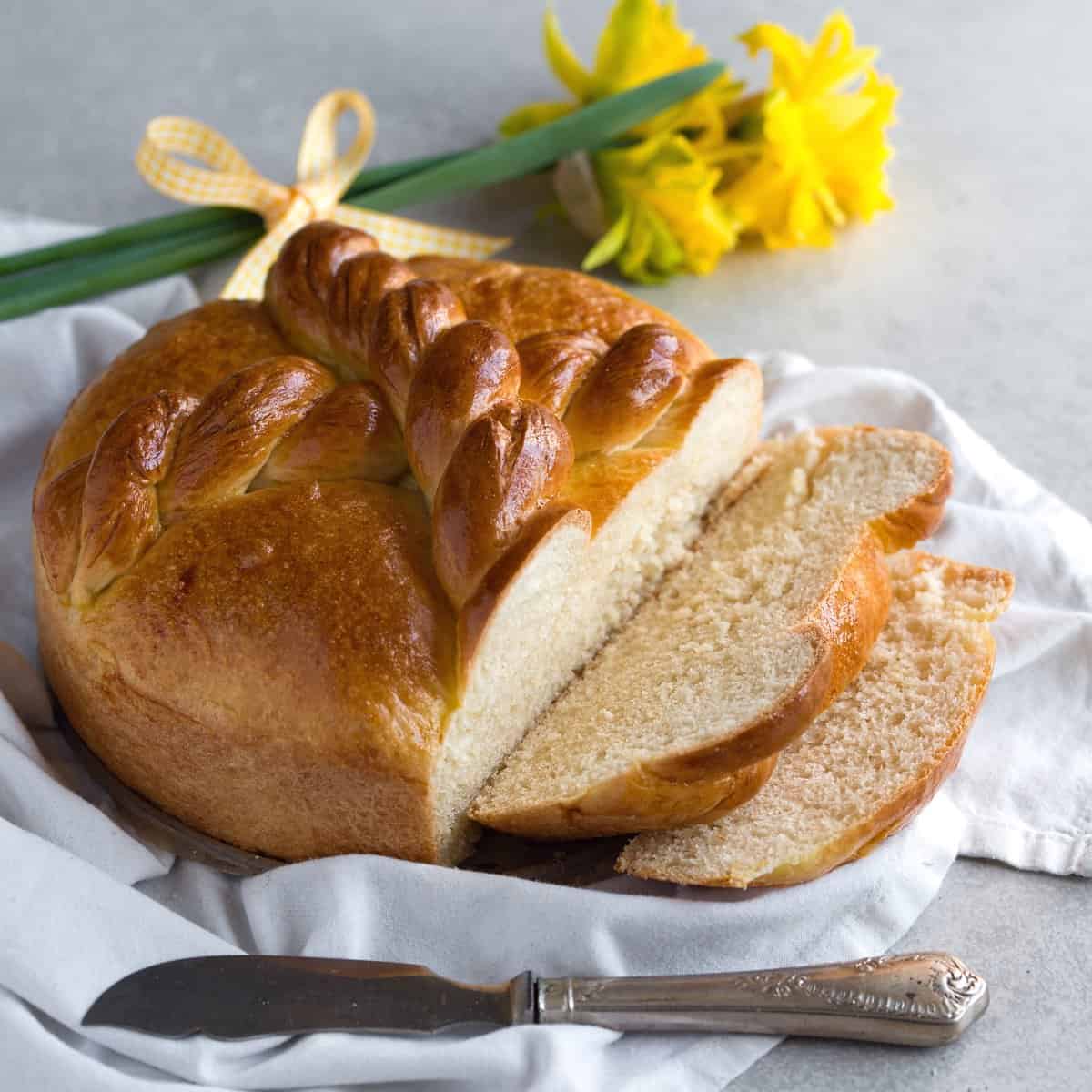
Monica
Ahoj
I noticed there were no instructions for when to add the milk?
Petra Kupská
Ahoj Monica, thank you for your sharp eye. The milk is poured in immediately after adding the eggs to the batter. I’ve already edited the information in the recipe card – step 5. Happy Easter (veselé Velikonoce) from the Czech!
Nancy
My Czech Grandmother made the Lamb cake every year for Easter!I am still making it, as well as my 4 grown daughters!! It has evolved into a frosted Lamb decorated with candies and surrounded by homemade Easter eggs. I love your site as it brings back many happy recipes of my youth. My eldest daughter makes the Christmas Houska for us each year. Thank you.
Petra Kupská
I love the way you present the lamb cake! 🙂 In the Czech Republic, we also put "Beránek" cake on a platter and place colored Easter eggs around it; it looks very nice. Christmas Houska is called vánočka nowadays, and its Easter variation is called Mazanec - here is a recipe: https://www.cooklikeczechs.com/velikonocni-mazanec-czech-sweet-easter-bread/
Greetings from Bohemia, Petra
R
Where can you buy a Czech lamb pan?
Petra Kupská
If you are located in the US, I suggest Amazon.com and the Czech brand Tescoma. You can find the lamb pan HERE. However, it is a bit pricey :/, I see in the Czech Republic the price is half.
Donna
Do you know if this recipe was around in the 1960's A friend of my grandmother used to make us a lamb cake every Easter .It was a very different tasting cake than I have ever had since. It was somewhat dense but delicious. There was white icing and coconut covering the lamb. I've never been able to find the recipe. I'm wondering if this could be it
Petra Kupská
Ahoj Donna, thank you for your comment. Every family has a slightly different lamb cake recipe, and it's hard to say what your grandmother's friend made. However, this recipe contains quite a lot of butter; it is not dry inside but soft and kind of moist. When it comes to decorating, Czechs usually just dust the surface of the lamb with icing sugar (no cream icing). Best wishes, Petra
Hana
Hi Donna, there are many different recipes for beranek, there is one dough type where you add tvaroh (quark, a soft, fresh un-aged cheese similar to Philadelphia cheese but softer). This might be what you are talking about. Quark makes the cake more dense than the sponge type dough. Some also use white chocolate as a glaze and sprinkle with shaved coconut to imitate the lamb's fur. You can google Velikonoční beránek z tvarohového těsta or Velikonoční beránek tvarohový if you want to check it out. If you hit 'translate this page' next to the Google search result you wish to view you might get a decent (not perfect) English translation to read through. Hope I helped 🙂
Marion Krejci Langguth
Planning to bake this today. So happy to add to the knowledge of my heritage, as I am a pure-bred Bohemian. Thank you!
Petra Kupská
You are very welcome and fingers crossed for success! Have a blessed Easter, Petra 🙂
Joan D. Ford
I just heard about this Beronic Lamb cake so just wondered the origin..I thought it was a Polish or a Mediterranean pound cake . I then found this recipe made with buttemilk and oil. I think that make a moist cake. Another recipe used 8 eggs. I happen to make a carrot cake this Easter with ground oat flour , oil and 4 eggs. Our organist was excited to tell me about her lamb pound cake her grandmother baked for her family. I suppose could make a sheet cake and carve to the shape of a lamb then decorate or just sprinkle with confectioners sugar.. Thank you.
Anicka Cooklikeczechs.com
Joan, thank you for your comment. This recipe for Lamb Cake uses three eggs - trust me, that's enough for a successful cake. In the Czech Republic, lamb cake is always baked in a special lamb-shaped tin (lamb cake pan), and I honestly have no experience with baking a cake on a sheet cake pan and cutting it into a lamb shape afterwards. If you try it, let me know what the result was!
Dusan
The recipe is, as always, just perfect. Thank you. Would you have some good tricks on how to use a double-sided mold? I was able to buy a cool antique mold here in California but I am not sure how to use it. Bake ti in two separated, cut flat both parts and "glue" together using some cake filling....or try to fill both halves and tight them together with wire....or so? As you can imagine my antique mold is missing instructions....:-))))).....Thanks!
Nancy
I have a two-sided lamb cake mold that I have been using for a number of years. I thoroughly grease and flour (or use Pam Baking Spray) the mold and fill the FRONT half of the mold to about 1/2" - 3/4" from the top edge and place the prepared BACK half of the mold on top and using wire tie the two pieces together.
My mold has little "feet" on the front portion so that it will sit level in the oven on a sheet pan. The top portion also has vent holes which I use to test for doneness.
When done, remove from oven to cooling rack, then remove wire carefully. Let cool another 10-15 minutes and GENTLY remove top (BACK). Again, let cool about 5 minutes and using a cooling rack invert mold to rack. I try to stand the lamb upright as soon as possible to prevent lines from rack appearing on the back.
Good Luck! Your Lamb cake will be lovely. Happy Easter
Petra Kupská
Nancy, thank you very much for your perfect advice!
Lucie
I have a similar mold. I fill the front mold (with lamb face) almost to the top, then cover that with the back mold and attach the two with butcher’s thread - my mold has a hole on both pieces for that. I bake the cake with a cookie sheet under to catch any spill - although I’ve never had any overflow. It comes out nicely each time
Petra Kupská
Thank you, Lucie, for your helpful insight!
Petra Kupská
Hi Dusan, thanks for your comment! I admit I don't have any experience with the two-piece lamb cake mold, but I think Nancy and Lucie have given you some helpful hints. Fingers crossed that the Easter cake is a success!
TOMAS SEDLACEK
HAPPY EASTER.
LOVED THE BERANEK MOLD & PLATE TO ACCOMMODATE THE FINISHED CAKE. THE EASTER EGGS WERE DEFINITELY IN CZECH DESIGN. MY BOWL OF EASTER EGGS WERE GIVEN TO ME BY A VERY LONG TIME FRIEND OVER A LONG PERIOD OF TIME. HIS LINE WORK IS EXQUISITE. THE BOWL WILL BE THE CENTER PEICE FOR OUR EASTER CELEBRATION..IF YOU WOULD LIKE A PHOTO, IWOULD BE DELIGHTED TO SEND FROM MY PHONE. PLEASE LET ME KNOW.
NASDAR TOMAS SEDLACEK
Petra Kupská
Hi Tomas, thank you for your kind words, and I believe you had a nice Easter time! Of course, I would love to receive a photo of your lamb cake. Here are the contact details: petra@cooklikeczechs.com
Michaela
Thank you for sharing this recipe.
Please allow me to point out that the Easter Lamb baked in the way you describe is a German (Southern German and Austrian) recipe.
Habsburg - Austria - is the place where many Central European baking recipes originate from. German people lived in the Czech Republic, too. And that's where this recipe goes back to, originates from.
Petra Kupská
It is possible. As far as I know, lamb-shaped cakes are mentioned in Czech historical sources dating back to the Middle Ages. The colonization of the Czech borderlands by Germans began sometime in the 13th century at the invitation of Czech King Wenceslaus I. The Czech lands, situated in the heart of Europe, were influenced by various nations, just as the Czechs influenced their neighbors. Actually, it is difficult to trace the origin of individual dishes today; many appear in the national cuisines of European countries in modified forms.
Michaela
In the old continent, people baked with butter - instead of oil.
I tried your recipe. I reduced the amount of sugar consuderably.
Petra Kupská
Thank you for your comment, Michaela. The question is, what constitutes an old recipe? For instance, this one with Kefir is over 50 years old. Is that little or a lot? Every era called for different ingredients that were available at the time. The oldest cookbook I have dates back to 1947 (by Marie Janků Sandtnerová)—the x.th edition of a cookbook originally published in 1924, during the so-called First Republic. The recipe for lamb cake in this cookbook calls for butter. My grandmother, born in 1921, to whom the cookbook belonged, told me that there wasn't much money for butter in the post-war economy, so the butter was often replaced with oil and other fat.